Samsung Series 7 NP700Z7C Review
by Jarred Walton on August 16, 2012 2:05 AM ESTSamsung Series 7 LCD: About As Good As TN Gets
Apple, ASUS, HP, Lenovo, and Sony have made some waves over the past year by equipping certain laptop models with IPS displays. In the case of Apple, they’re shipping the highest resolution display ever seen in a consumer notebook. ASUS hasn’t gone quite as far as Apple, but they still have a couple of the highest DPI displays we’ve ever seen with 1080p panels in the 11.6” UX21A and the 13.3” UX31A. We’d love to see more manufacturers jump on the high quality IPS display bandwagon; Samsung isn’t there with the Series 7, but they do get a couple things right: first, they use a high contrast display, and second they use a matte LCD. Here’s how it stacks up to the competition.
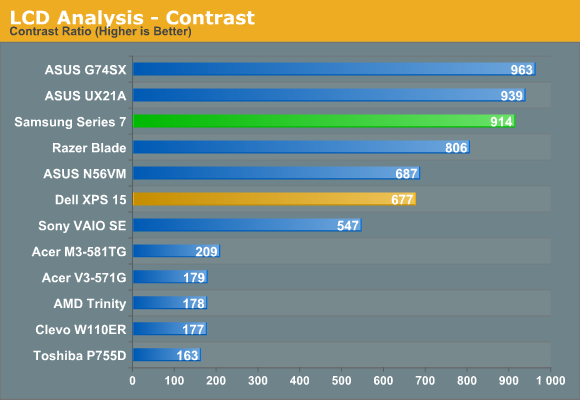
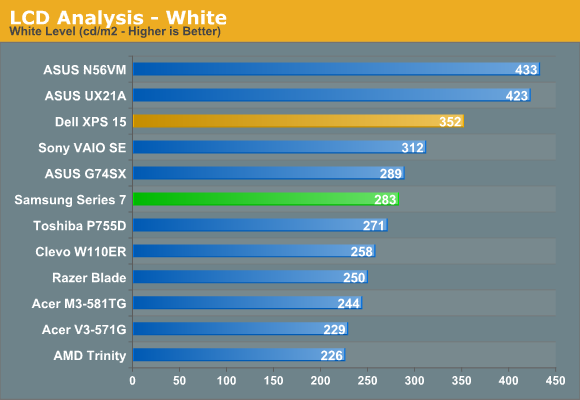
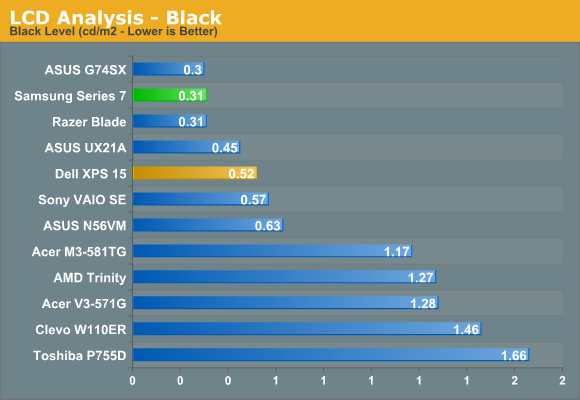
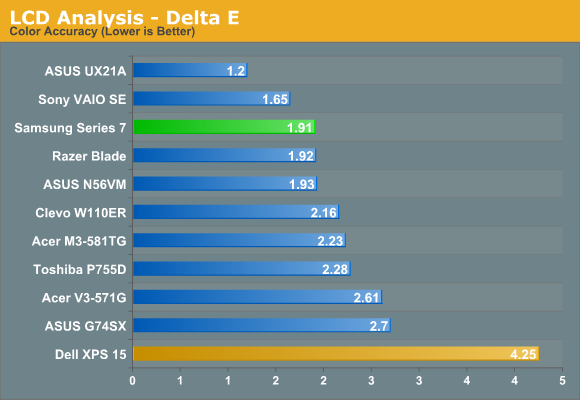
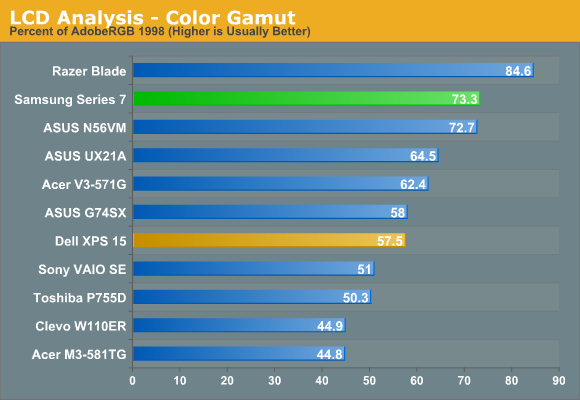
Contrast is very good at 914:1, and when you factor in the other laptops using glossy displays it’s even better—matte LCDs usually give up about 10% of their contrast. The maximum white level is a bit lower than we’d like, registering 283 nits, but again the matte surface will help if you use the notebook in brightly lit environments. Perhaps equally important is that the colors are very good—only the IPS displays in the ASUS UX21A and the Sony VAIO SE deliver lower Delta E results, and if you work in the sRGB color space the Series 7 is just about perfect. I still prefer IPS displays like that in the VAIO SE personally, even if the color space isn’t quite as good, but opinions on that differ.
Of course the biggest problem with TN panels (besides using 6-bits and dithering instead of true 8-bit color) is that vertical viewing angles aren’t very good. The Series 7 appears to use a Chi Mei/Innolux N173HGE-L11, and its viewing angles are much better than low-end TN panels, but if you happen to be sitting in coach on a flight trying to get work done (like I was at one point during this review), it’s still going to present some problems. Then again, I’m not sure how many people would actually try using a 17.3” notebook on a plane.


_thumb.jpg)
_thumb.jpg)
_thumb.jpg)
_thumb.jpg)
_thumb.jpg)
_thumb.jpg)








50 Comments
View All Comments
nerd1 - Sunday, August 19, 2012 - link
Exactly WHAT problems? I own 13" MBA and my friend has series 9 2011 model and I think s9 is better in almost all aspects.bennyg - Saturday, August 18, 2012 - link
Where are the comparison with the 95% AUO 1080p TN screens used in Clevo's high end gaming laptopsB156HW01 v4, v7
and the ones used in 17"
Very ironic how AUO and Chimei are responsible for so many cheap crappy low res screens now they're the only ones turning out top notch high res TNs!
rwei - Monday, August 20, 2012 - link
(1) EVEN MORE SHALLOW KEY TRAVEL!!!http://www.engadget.com/2012/08/20/synaptics-enter...
(2) Clickpads with NO BUTTONS AT ALL!!!
http://www.engadget.com/2012/08/20/synaptics-force...
Gonna be some good-@$$ rants coming up in the near future. Bet you're loving Synaptics today.
jsa - Tuesday, August 21, 2012 - link
My 2004 Dell Inspiron 8600 just can't keep up with some fairly basic tasks, so I've been following reviews here (and elsewhere to supplement--wish there were more here!) for the past few months to try to decide on a new machine. The Asus N56V is currently my top contender after being disappointed with the findings in the last couple of reviews.One thing I haven't gotten straight in my head is whether there is some benefit to having the discrete GPU for a nongamer (or occasional gamer at most) such as myself. I understand there may be some battery life disadvantages to having it; are there also some benefits I might reap? Perhaps the whole question is moot as I haven't really seen any interesting options for use as a main computer (not quite ready to relegate the optical drive to my secondary machine), that are limited to integrated graphics.
One thing that seems important to me is having good sound, as I'd like to move around the house and, if I'm going to stay put for a while, listen to music from the notebook without dealing with external speakers; another is a high resolution display, because I like to fit a lot on that screen. The main other contenders seem to be the Series 7 reviewed here, which has a much nicer case and maybe better sound and keyboard, but not as good a screen, much more expensive, and some disappointments in the review; the HP Pavilion dv6, which also seems to have better sound than the N56V, but seems like it may have quality control issues (as well as a glossy screen); the Lenovo Y580, which I don't know much about, but doesn't seem quite as appealing as the N56V; and the Sony Vaio S 15", which generally seems like a good machine, but doesn't seem to have very good sound at all.
Apologies if this isn't appropriate as a comment.
infoilrator - Friday, August 24, 2012 - link
The greatest difficulty is to extend performance, size, cost, and battery life.With speakers more sound is easier with larger speakers. Some of the USB plug ins do pretty well. Being small, light, and power efficient is a contradiction. Piezo tweeters can be loud and efficent if you sacrifice bass. There are dome speakers thar do better, these get expensive fast. Cone speakers are a possible answer, require space and magnets.
Possibly someone makes cordless USB headphones for you, a possible answer.
Every laptop is a marketing/price compromise.
Recently SSD prices have dropped. Please remember lead time in choosing components for mass production. You can have "just in time delivery" but prices and choices can reflect over a year back. Or more. Contracts have to e signed so assembly lines are not idle for want of parts
If prices of HDDs and SSDs continue to fall expect this first to appear with smaller producers.
infoilrator - Friday, August 24, 2012 - link
Around the house maybe a wireless connection to an existing sound system?jsa - Sunday, August 26, 2012 - link
Thanks for all your insights. I don't have an existing sound system, but it may be worth getting rid of the "good sound" requirement, since I won't get great sound, anyway. Then I can either implement a wireless system of some kind or check out USB speakers. (Cordless USB headphones are a pretty interesting option, but don't work when my girlfriend is over.)That opens up my options, and in particular makes the Vaio S 15.5" a more attractive choice.
As someone who wouldn't be playing games much (if ever), is there a strong benefit to losing the dedicated GPU, or is it pretty much a draw?
jemccloskey - Sunday, October 21, 2012 - link
Sorry if I'm posting and this thread is already dead. I have a Samsung Series 7 17" - NP700Z7C-S01US and I am unable to frame rates even close to those mentioned in the benchmark results. I get frame rates between 8-12 @ 1366x768 on Batman Arkham City, Battlefield 3, Fallout: New Vegas. DX11 on and off etc..This is with drivers ranging from 296.87 through all betas and the current released version 306.97. In addition, I have tried every configuration and I have specified to use the nVidia discrete graphics: via context menu, Physx config, and 3D Settings. However, I am unable to pass the 12 fps threshhold. In addition I have installed, the latest BIOS update, Windows7(64bit ultimate and pro) 3 different times, and used Nivdia Optimus GPU Tools state viewer, GPU-Z and Throttlestop 500a.
Just to sum things up: I get better fps average results from using the Intel IGP HD Graphics 4000. And I'm not confusing the nvidia with the intel when profiling. Verified harware ID's, throughput and bandwidth via 3 different utilities.
I have played with all power management issues etc...In any case, I'm totally confused as to how to achieve the frame rates mentioned in your benchmarks. I must be doing something wrong. Any suggestions would be appreciated.
Thank you,
jmccloskey@gmail.com
FlavioJuan - Tuesday, November 13, 2012 - link
I have bought this great Computer a week ago.The GOOD ones
It has a good design is lightweight (4 a 17" Laptop)
Aluminum design is also great looking
Battery last almost the 6 promoted hours,
Bright is OK
Multi touch pad works fine.
Sound is also OK.
Great Battery life extender feature in BIOS.
The BAD ones
For this kind of “high range” computer, I really do not understand why max RAM was designed up to 8Gb.
Battery is not removable (not even a switch to turn it off).
Boot from Pen drive not available in BIOS boot options.
No Blue ray reader.
No button to eject discs from reader, you can eject disc only from windows. (Not even an eject hole) so if you don’t have Windows running… there is no way to take a disc out.
A lot of Samsung proprietary software must be loaded to get this machine full working,
Several features are software dependent, like for example, keyboard backlight, controlled by Fn + F9 F10, so u have to wait till complete windows + driver properly loaded, to have this feature available.
If you are on a non-dark environment then every time you wish the keyboard backlight ON, you will receive a warning telling you that you can just turn in ON only in dark environment.
(In the other hand I tried to disable Light sensor from control Panel >Sensor but it didn’t works. So the solution I have found for this issue was covering the sensor with a coin or piece of tape. Really amazing!)
But what I really hate, (and this seems not only belongs to Samsung laptops, but for most of suppliers) is all the garbage software pre-installed on a new machine.
I buy a new laptop every year, and all I wish is a CLEAN computer installed just with SO + DRV.
I spent almost a day cleaning it in order to get the machine working without all these pre-installed software. Because in this process, sometimes uninstall some vital soft, and as
Re-installing doesn’t works properly, the only solution is perform a complete recovery then start again with the task.
I would prefer my windows 7 working at full range just with my applications instead to waste resources with all the Samsung resident softs that degrades my machine's performance.
But this kind of practice seems to be normal for all the laptop suppliers.
Could we (the customers) do something to change it?
Model NP700Z7C-S03US
SN / HUY691DC800028
Purchased on oct 30 2012 Tiger direct Miami, FL
Best regards for everybody.
Samsung Battery - Saturday, December 9, 2017 - link
If you face any issue regarding Samsung Laptop Battery then feel free to visit.https://laptopbattery.ae/samsung.html